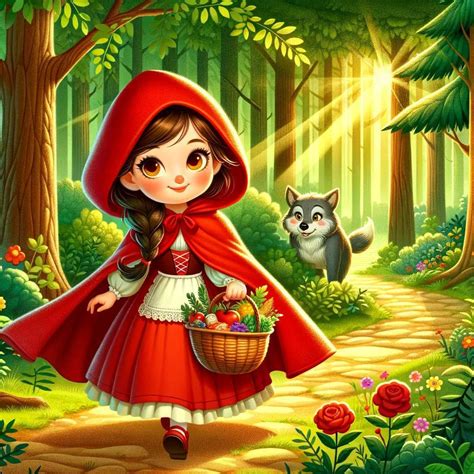The story of Little Red Riding Hood is one of the most recognizable and enduring fairy tales of all time. With its origins dating back to the 17th century, this tale has been retold and reinterpreted in countless ways, captivating the hearts of children and adults alike. At its core, the story revolves around a young girl's journey to visit her sick grandmother, her encounter with a sly wolf, and the ultimate rescue by a brave woodsman. However, the narrative is rich in symbolism, character development, and moral lessons, making it a treasure trove for analysis and exploration.
Historical Context and Evolution of the Tale

The earliest known publication of Little Red Riding Hood was in 1697 by Charles Perrault, a French author, in his collection of fairy tales titled “Histoires ou Contes du Temps Passé” (Tales and Stories of the Past). Perrault’s version, however, was not the first oral telling of the story, as similar narratives can be found in European folklore from earlier periods. The tale gained further popularity with the Brothers Grimm’s publication in 1812, titled “Kinder- und Hausmärchen” (Children’s and Household Tales), which introduced the story to a wider German-speaking audience. Over time, Little Red Riding Hood has undergone numerous adaptations, including stage plays, films, and even operas, each contributing to its enduring presence in popular culture.
Character Analysis: Little Red Riding Hood and the Wolf
At the heart of the story are its two main characters: Little Red Riding Hood, the naive and kind-hearted protagonist, and the wolf, the cunning antagonist. Little Red Riding Hood’s character serves as a symbol of innocence and goodness, while the wolf represents deception and evil. Their encounter in the forest marks a turning point in the tale, as it sets the stage for the wolf’s plan to deceive and devour both Little Red Riding Hood and her grandmother. The dynamic between these characters explores themes of trust, vulnerability, and the consequences of straying from the path of righteousness.
| Character Traits | Little Red Riding Hood | The Wolf |
|---|---|---|
| Primary Motivation | To visit and care for her sick grandmother | To deceive and devour Little Red Riding Hood and her grandmother |
| Personality | Naive, kind-hearted, obedient | Cunning, manipulative, hungry |
| Role in the Story | Protagonist, symbol of innocence and goodness | Antagonist, symbol of deception and evil |

Moral Lessons and Symbolism

Beyond its entertaining narrative, Little Red Riding Hood offers several moral lessons and symbols that have been interpreted in various ways. The story warns children about the dangers of talking to strangers and the importance of obeying their parents. The wolf, with his ability to disguise himself as the grandmother, symbolizes the deceptive nature of evil and the need for vigilance. The woods, where the encounter takes place, represent a transitional space between safety and danger, emphasizing the importance of making wise choices in uncertain situations.
The Role of the Woodsman: Savior and Symbol of Justice
The woodsman, who ultimately saves Little Red Riding Hood and her grandmother by cutting open the wolf’s stomach, is often seen as a symbol of justice and salvation. His character represents the intervention of good in the face of evil, restoring order and safety to the narrative. The woodsman’s actions also underscore the theme of rescue and redemption, suggesting that even in the darkest moments, help can arrive, and justice can prevail.
Key Points
- The story of Little Red Riding Hood has its roots in 17th-century European folklore, with the first published version by Charles Perrault in 1697.
- The tale explores universal themes such as the struggle between good and evil, the importance of obedience, and the dangers of deception.
- Characters like Little Red Riding Hood and the wolf serve as symbols of innocence, goodness, deception, and evil, respectively.
- The narrative offers moral lessons about safety, the importance of making wise choices, and the role of justice in overcoming evil.
- Adaptations and interpretations of Little Red Riding Hood continue to evolve, reflecting changing societal values and artistic expressions.
Cultural Impact and Adaptations
Little Red Riding Hood’s influence extends far beyond the realm of children’s literature. The tale has been adapted into numerous films, stage productions, and even musical compositions, each offering a unique interpretation of the classic story. These adaptations not only reflect the creativity of their creators but also demonstrate the tale’s versatility and its ability to captivate diverse audiences. Furthermore, the story’s themes and characters have become part of the cultural lexicon, symbolizing certain archetypes and moral lessons that transcend the narrative itself.
In conclusion, the story of Little Red Riding Hood is a rich tapestry of themes, characters, and moral lessons that have captivated audiences for centuries. Its evolution from a simple folk tale to a global phenomenon underscores the power of storytelling to entertain, educate, and reflect the human condition. As a cultural icon, Little Red Riding Hood continues to inspire new adaptations and interpretations, ensuring its place in the hearts and imaginations of people around the world.
What is the historical context of Little Red Riding Hood?
+Little Red Riding Hood has its origins in 17th-century European folklore, with the first published version by Charles Perrault in 1697. The story gained further popularity with the Brothers Grimm’s publication in 1812.
What moral lessons does Little Red Riding Hood teach?
+The tale teaches several moral lessons, including the importance of obeying parents, the dangers of talking to strangers, and the struggle between good and evil. It also highlights the role of justice and salvation in overcoming evil.
How has Little Red Riding Hood been adapted and interpreted over time?
+Little Red Riding Hood has been adapted into numerous films, stage productions, and musical compositions, each offering a unique interpretation of the classic story. These adaptations reflect the creativity of their creators and the tale’s versatility in captivating diverse audiences.



